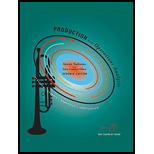
Concept explainers
Interpretation:One of the system for
Concept Introduction:The input toMRP is the demand of the final item for which the dependent items are to be managed. Demand of the final item over the planning timeframe can be taken in many ways-ranging from just historical data to forecasting/estimation methods. The forecasting methods can make, rather accurate forecasts, allowing fluctuations during different periods, even if wide. Alternatively, the forecasts can be evened out so as to keep on producing without major fluctuations. (In lean terminology, this is called levelling the load). Each of these i.e forecasts with accuracy or with consistency, has its own advantages and disadvantages.
Want to see the full answer?
Check out a sample textbook solution
Chapter 8 Solutions
Production and Operations Analysis, Seventh Edition
- As the production planner for Xiangling Hu Products, Inc., you have been given a bill of material for a bracket that is made up of a base, 2 springs, and 4 clamps. The base is assembled from 1 clamp and 2housings. Each clamp has 1 handle and 1 casting. Each housing has 2 bearings and 1 shaft. There is no inventory on hand. Your boss at Xiangling Hu Products, Inc., has just provided you with the schedule and lead times for the bracket. The unit is to be prepared in week 12.The lead times for the components are bracket (1 week), base (1 week), spring (1 week), clamp (1 week), housing (3weeks), handle (2weeks), casting (4weeks), bearing (1 week), and shaft (1 week). Part 3 b) In what week do you need to start the castings? The castings need to be started in week enter your response here (enter your response as a whole number).arrow_forwardAn end item’s demand forecasts for the next 6 weeks are 30 units, followed by forecasts of 25 units for weeks 7 through 10. The current on-hand inventory is 60 units. The order policy is to produce in lots of 100. The booked customer orders for the item, starting with week 1, are 22, 30, 15, 11, 0, 0, 9, 0, 0, and 0 units. The lead time is 2 weeks.a. Develop an MPS for this end item.b. The marketing department has received six orders for this item in the following sequence:Order 1 is for 40 units to be delivered in period 3Order 2 is for 60 units to be delivered in period 4Order 3 is for 70 units to be delivered in period 6Order 4 is for 40 units to be delivered in period 3Order 5 is for 20 units to be delivered in period 5Order 6 is for 115 units to be delivered in period 9Assuming that the prospective MPS you developed in part (a) does not change, which orders would you be able to accept based on the available to promise (ATP)?arrow_forwardBriefly describe each of these priority rules:a. FCFSb. SPTc. EDDd. S/Oe. Rusharrow_forward
- User Solutions, Inc.usersolutions.comExamine the features available from the system. Describe the use of the system for MRP planning and scheduling.arrow_forwardKnowing the MRP system's data processing methodology is crucial.arrow_forwardUnderstanding the MRP system's data processing methodology is crucial.arrow_forward
- Discuss the benefits and challenges associated with the implementation of an MRP system?arrow_forwardWhat precisely is the key distinction between planning for the long term and planning for the short term when it comes to process scheduling?arrow_forwardProduct A is an end item and is made from two units of B and four of C. B is made of three units of D and two of E. A has a lead time of 1 week, B,C AND E have a lead time of 2 weeks and D and F have a lead time of 3 weeks. Assume we are using L4L. question: If 100 units of A are required in Week 10, develop the MRP schedule, specifying when items are to be ordered and recieved. There are currently no units of inventory on hand.arrow_forward
- Before a master schedule can be created what action is needed? A. Aggregate the aggregate plan into specific model numbers B. Disaggregate the specific model numbers C. Disaggregate the aggregate plan into specific model numbers D. Aggregate the specific model numbers into product families E. Disaggregate the business plan to create product families e.arrow_forwardAs the production planner for Xiangling Hu Products, Inc., you have been given a bill of material for a bracket that is made up of a base, 2 springs, and 4 clamps. The base is assembled from 1 clamp and 1 housing. Each clamp has 1 handle and 1 casting. Each housing has 2 bearings and 1 shaft. There is no inventory on hand. This exercise contains only parts b and c. Part 2 The product structure is as follows: Bracket Base(1) Clamp(1) Handle(1) Casting(1) Spring(2) Housing(1) Shaft(1) Clamp(4) Bearing(2) Handle(1) Casting(1) Part 3 b) Determine the gross quantities needed of each item if you are to assemble 100 brackets. Base: enter your response here units (enter your response as a whole number). Spring: enter your response here units (enter your response as a whole number). Clamp: enter your response here units (enter your response as a whole number). Housing: enter your response here units (enter your…arrow_forwardAs the production planner for Xiangling Hu Products, Inc., you have been given a bill of material for a bracket that is made up of a base, 1 spring, and 3 clamps. The base is assembled from 2 clamps and 2 housings. Each clamp has 1 handle and 2 castings. Each housing has 1 bearing and 2 shafts. There is no inventory on hand. This exercise contains only parts b and c. The product structure is as follows: Bracket Base(1) Clamp(2) Handle(1) Casting(2) Spring(1) Housing(2) Shaft(2) Clamp(3) Bearing(1) Handle(1) Casting(2) b) Determine the gross quantities needed of each item if you are to assemble 50 brackets. Base: ? Spring: ? Clamp: ? Housing: ? Handle: ? Casting: ? Bearing: ? Shaft: ?arrow_forward
 Practical Management ScienceOperations ManagementISBN:9781337406659Author:WINSTON, Wayne L.Publisher:Cengage,
Practical Management ScienceOperations ManagementISBN:9781337406659Author:WINSTON, Wayne L.Publisher:Cengage,
